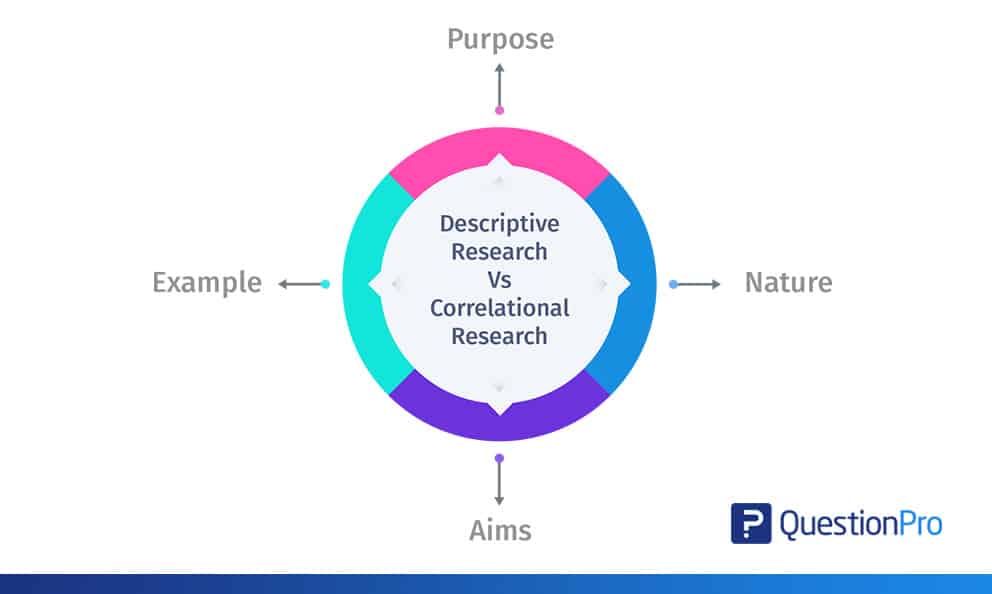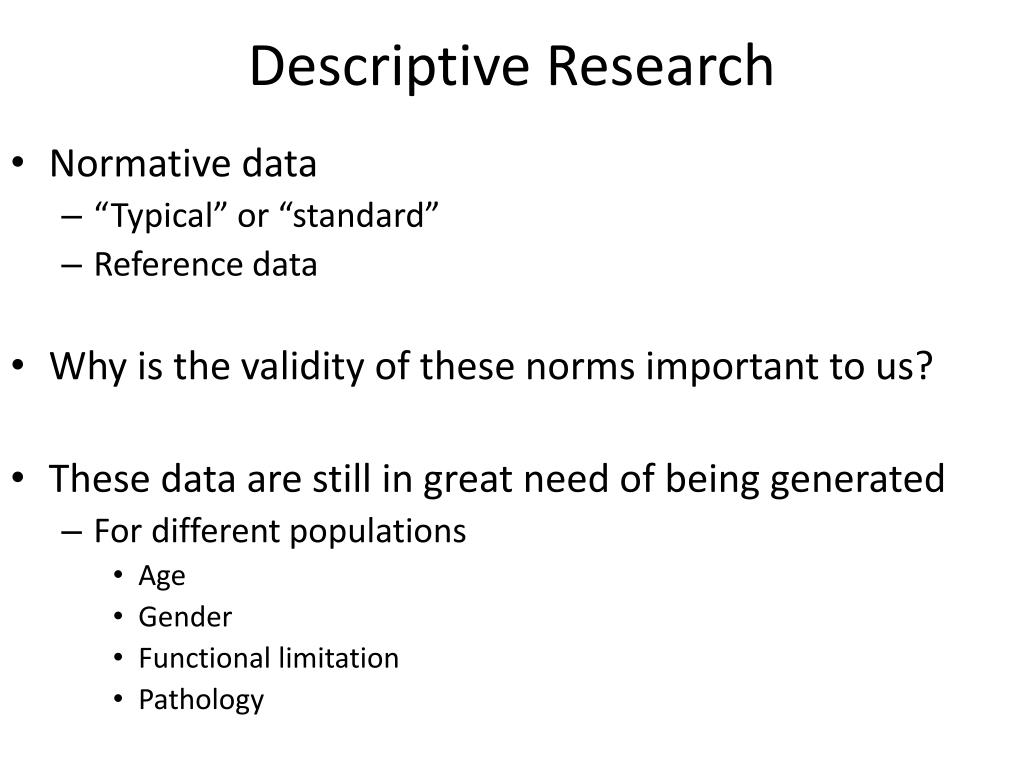Descriptive Research Design Definition, Methods & Examples
Table Of Content

Ethical standards were reported in greater than 89% ofall articles and most articles included an in-depth description of data analysis(83.6%) and development of categories or themes (92.7%). Finally, allresearchers clearly stated their findings in relation to research questions/objectives.Researchers of 83.3% of the articles discussed the credibility of their findings(see Table 1). Information acquired from observational research takes the form of “field notes” that involves documenting what the researcher actually sees and hears while in the field. Findings do not consist of conclusive statements derived from numbers and statistics because field research involves analysis of words and observations of behavior.
Child Care and Early Education Research Connections

It can also inform the next line of research, including the research method that should be used. It can also be carried out using the qualitative research method, to properly describe the research problem. This is because descriptive research is more explanatory than exploratory or experimental.
Multiple types of data can be collected
Descriptive research is a research method describing the characteristics of the population or phenomenon studied. This descriptive methodology focuses more on the “what” of the research subject than the “why” of the research subject. You can choose just one data collection method, or use several methods in the same study.
Design and implementation characteristics of research training for rural health professionals: a qualitative descriptive ... - BMC Medical Education
Design and implementation characteristics of research training for rural health professionals: a qualitative descriptive ....
Posted: Thu, 30 Mar 2023 07:00:00 GMT [source]
Data Analysis
So, be sure to think through your choices carefully and make sure that you have backup plans for any existential risks. Remember that a relatively simple methodology executed well generally will typically earn better marks than a highly-complex methodology executed poorly. As you can probably imagine, ethnographic research design has the ability to provide rich, contextually embedded insights into the socio-cultural dynamics of human behaviour within a natural, uncontrived setting. Naturally, however, it does come with its own set of challenges, including researcher bias (since the researcher can become quite immersed in the group), participant confidentiality and, predictably, ethical complexities.
Observation methods
However, you can’t draw conclusions about cause and effect (because correlation doesn’t imply causation). A well-planned research design helps ensure that your methods match your research aims and that you use the right kind of analysis for your data. Keep in mind that when it comes to research, it’s important to manage your risks and play as conservatively as possible. If your entire project relies on you achieving a huge sample, having access to niche equipment or holding interviews with very difficult-to-reach participants, you’re creating risks that could kill your project.
This may help generate hypotheses regarding the cause of the disease, which can then be verified using another, more complex design. They often have similar approaches in terms of data collection, but focus on different aspects when analysing the data. For example, you could adopt a phenomenological design to study why cancer survivors have such varied perceptions of their lives after overcoming their disease. This could be achieved by interviewing survivors and then analysing the data using a qualitative analysis method such as thematic analysis to identify commonalities and differences.
Uncontrolled variables
Participants’ perceptions of specific care, interventions, or programswere described in detail in 11 articles. All researchers presented their findings withextensive descriptions including themes or categories. In 25 of 55 articles, figures ortables were also presented to illustrate or summarize the findings.
For example, if you want to understand the fashion trends we mentioned earlier, you would set up a study in which a researcher observes people in the respondent’s natural environment to understand their habits and preferences. This is because researchers aim to gather data in a natural setting to avoid swaying respondents. Descriptive research is a research method used to try and determine the characteristics of a population or particular phenomenon. Descriptive research design is a type of research methodology that aims to describe or document the characteristics, behaviors, attitudes, opinions, or perceptions of a group or population being studied.
Step 4: Choose your data collection methods
A documentary survey involves gathering and analyzing information using pre-existing data that is already available. In documentary studies, the researcher evaluates the available literature on the research topic. The case study method involves the in-depth research of individuals or groups of individuals. Case studies involve gathering detailed data on a narrowly defined subject rather than gathering a large volume of data to identify correlations and patterns.
On the contrary, this design typically also involves in-depth interviews to explore participants’ views, beliefs, etc. However, unobtrusive observation is a core component of the ethnographic approach. We’ll explain the most common research design types for both qualitative and quantitative research projects, whether that is for a full dissertation or thesis, or a smaller research paper or article. Descriptive research aims to accurately and systematically describe a population, situation or phenomenon.
Data analysis involves using various methodologies, enabling the researcher to evaluate and provide results regarding validity and reliability. Despite certain parallels, descriptive research concentrates on describing phenomena, while qualitative research aims to understand people better. This approach entails carefully examining a particular group, person, or event over time. You can learn something new about the study topic by using a small group to better understand the dynamics of the entire group. It enables researchers to precisely and methodically describe a population, circumstance, or phenomenon. To conduct effective research, you need to know a scenario’s or target population’s who, what, and where.
Experimental research, on the other hand, involves manipulating variables and controlling conditions to investigate cause-and-effect relationships. It aims to establish causal relationships by introducing an intervention or treatment and observing the resulting effects. It focuses on providing an accurate and detailed account of an already existing state of affairs between variables.
Descriptive research only provides a snapshot of the current situation and cannot establish cause-and-effect relationships. By gathering information on the habits of shoppers, retailers can get a better understanding of the purchases being made. This means you’ll need to conduct further research to get a more complete picture of a situation.
They can also decide how they want to collect the data, online, offline, or via phone. The description is used for frequencies, averages, and other statistical calculations. Often the best approach, prior to writing descriptive research, is to conduct a survey investigation. Qualitative research often has the aim of description and researchers may follow up with examinations of why the observations exist and what the implications of the findings are.
More specifically, it helps answer the what, when, where, and how questions regarding the research problem rather than the why. Causality studies may be thought of as understanding a phenomenon in terms of conditional statements in the form, “If X, then Y.” This type of research is used to measure what impact a specific change will have on existing norms and assumptions. Causal effect (nomothetic perspective) occurs when variation in one phenomenon, an independent variable, leads to or results, on average, in variation in another phenomenon, the dependent variable. A case study is an in-depth study of a particular research problem rather than a sweeping statistical survey or comprehensive comparative inquiry. It is often used to narrow down a very broad field of research into one or a few easily researchable examples. The case study research design is also useful for testing whether a specific theory and model actually applies to phenomena in the real world.
Planning systematic procedures is especially important in quantitative research, where you need to precisely define your variables and ensure your measurements are reliable and valid. To make the research more manageable, and to draw more precise conclusions, you could focus on a narrower population – for example, Year 7 students in low-income areas of London. By comparing their outcomes in test scores, you can be more confident that it was the method of teaching (and not other variables) that caused any change in scores. Experiments are the strongest way to test cause-and-effect relationships without the risk of other variables influencing the results. However, their controlled conditions may not always reflect how things work in the real world.
Komentar
Posting Komentar